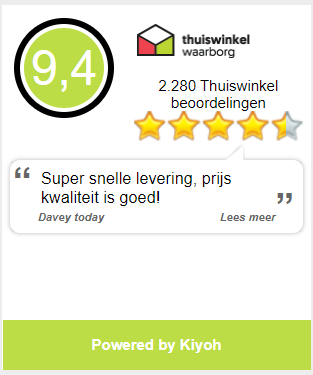Welk mes heb ik nodig?
chef's knife
A good chef's knife (gyuto is the Japanese version of this) or santoku is a real all-rounder, which makes this knife the basic tool for every chef and hobby chef. Chef's knives have a high blade so that you can place the fingers of the hand with which you hold the food against the side of the blade, this way you can work safely and very quickly. Most home cooks choose an 18-20cm blade, which is long enough to cut large quantities in one pass. Professional chefs usually opt for a blade of 23-26cm.
Paring knife / Petty / Potato peeler
In addition to being a chef's knife, this small knife is an indispensable partner in the kitchen! Use this blade to cut, peel, or decorate fruits and vegetables. Because this knife is shorter, it is very easy to handle. Whether you want to cut carrots on a board or remove the outer leaves from a head of lettuce, the office knife can do it all. The name of the petty blade is derived from the French word petit (small).
bread knife
By calling this serrated knife a bread knife, we are actually doing it a bit short. In addition to bread, you can also easily cut through large, hard or smooth vegetables such as cabbage, heads of iceberg lettuce, tomatoes and melon with this long serrated knife. It is better not to use a bread knife for meat and fish, because of the serrations you pull the fibers of the product apart. When you have bread with a hard crust, it can sometimes "splash", this is due to the hollow (concave) serrations. If you often cut bread with a hard crust, try a knife with convex ridges! A bread knife is almost always sharpened on the right, making it difficult for left-handers to cut straight. Nowadays there are also knives that are sharpened on both sides, so you do not necessarily need a left-handed knife.
carving knife
Whether you want to slice your ham like a knife through butter or slice your roast with surgical precision, one thing's for sure, you need a carving knife that's up to the task. With its long blade you can cut a slice of meat in one cutting movement so that you don't get any cutting marks in your meat. Because the blade is thinner than a chef's knife, the meat will stick less to the knife, making a carving knife also very suitable for cutting cooked meat: roasts, roulades and hams. (boneless!) While knife choices can be as subjective as the way you roast your meat, it's worth remembering a few simple rules when it comes to carving; let the meat rest under foil for at least 20 to 30 minutes. Second; don't cut your slices, use the full length of the blade with each cut in one direction.
boning knife
Boning knives are thin, sharp, (usually) flexible knives used to remove bones and skin from meat and fish. The special curved blade of the knife allows you to cut meat from bones and joints and its flexibility allows you to make thin, precise cuts. By selecting the right boning knife and learning the proper techniques for removing bone and skin, you will discover that the boning knife is very useful in the kitchen.
Flexibility is perhaps the most important aspect of a boning knife. If a flexible blade goes into a thicker/heavier cut of meat it will often break or bend, but if a stiff blade is used for fish it will be much more difficult to remove all the bones.
- Stiff: needed for thicker cuts. Very little to no flexibility.
- Flexible: normally smaller in size. These knives offer great flexibility and control.
If your main goal is to remove bones from fish or poultry, you need a flexible blade. Otherwise you will need a stiff knife.
Decision aid
If you are making a choice for a knife, you will mainly look at the handle (material or shape), the blade (thin/thick, long/short, etc.), and the crop. (full or half.)
Handle / Handle / Handle
With a good knife, the handle is ergonomically shaped and has no seams where dirt and bacteria can settle. The handle will play a major role in your choice: does it fit comfortably in your hand, does it fit in your hand, does the material feel nice, is the weight pleasant to work with for a long time? Please note that Japanese knives often have a right-handed handle and therefore do not fit comfortably in the hand for left-handers. There are many materials suitable for making a handle, a few examples are plastics such as fiberglass and nylon, deer antlers, bones, woods, semi-precious stones, leather and even ivory can be used (nowadaysoften mammoth ivory).
the blade
The shape of the blade depends on the task of the knife. For example, the chef's knife has a wide and long blade, while a filleting knife has a flexible, thin and narrow blade. European chef's knives are often convex so that you can make a rolling (locomotive) movement when cutting, Asian knives are more often straight for chopping. Chef's knives are wide because this allows for quick chopping while keeping your knuckles relatively safe.
Krop
The crop forms the transition from the blade to the handle. Usually you have the choice between a full or half crop. The bolster protects your hand so that it does not slide over the cutting surface and contributes to a good balance of a knife. With a full crop, the thickening runs to the heel of the edge, so you can't use the entire knife with cutting and it also gets in the way with sharpening. Half a crop also protects your hand, but narrows rather so that the cutting edge can continue in a straight line.
(For example, Wüsthof classic has a full crop, the Ikon series has a half)
Full crop: 
half crop:
tongs or stinger:
This is the extension of the blade and possibly the crop. With German knives this is often visible and two "scales" are secured with rivets, this is called a full tang. Although it was originally a sign of a good knife, there are now countless cheap knives available with this design and at least as many good knives without. Therefore, pay particular attention to the overall quality of the knife, which often says more about a knife than the design.




